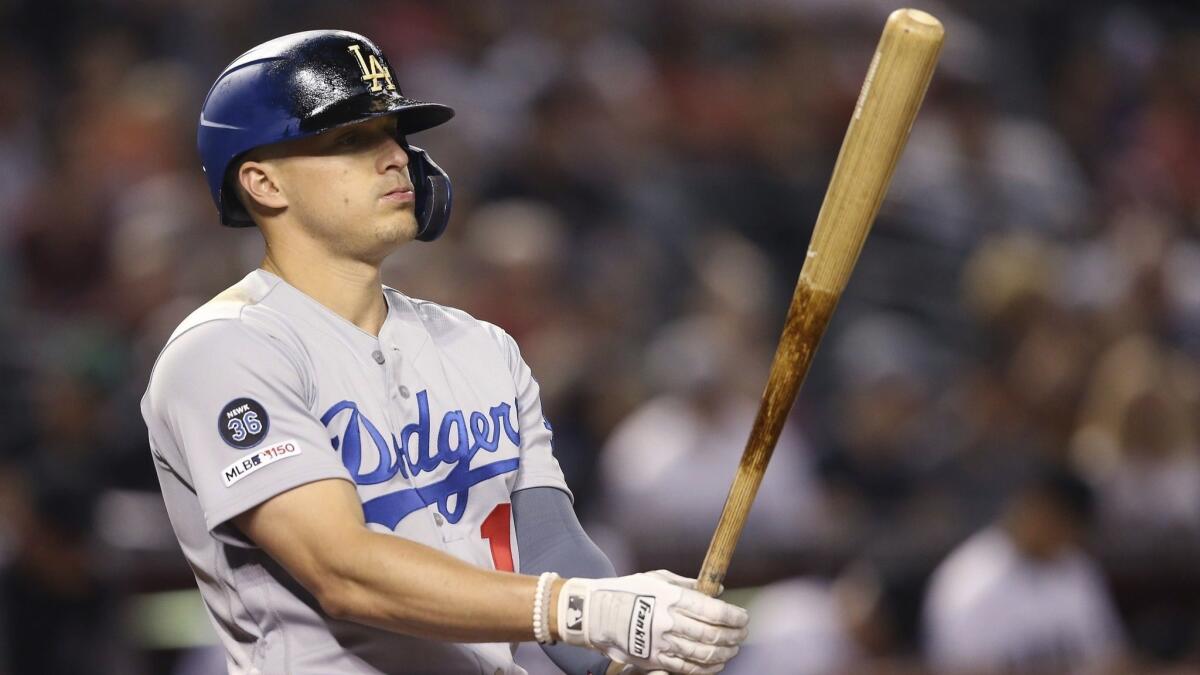Dodgers’ Enrique Hernandez started producing when he stopped chasing

Enrique Hernandez doesn’t call it pressure. That word, he says, is too strong to describe the onus he carried while mired in a two-month slump that cost him his coveted job as the Dodgers’ starting second baseman after years as a utility player. But it weighed on him. It made him wonder whether he was running out of time to prove he could consistently contribute to a club sprinting to another division title.
“More a sense of urgency,” Hernandez said. “At no point did I start panicking but it was almost like it was a little bit of a reality check. Like, ‘All right, this might be the one thing that gets you more consistent starts and it’s time to go. It’s now or never.’ And so far things have been going a lot better lately.”
The progress, however, encountered a speed bump in the fourth inning against the Angels Wednesday when Hernandez injured his left hand taking a swing. He appeared in enough pain to coax manager Dave Roberts and a trainer to check on him. He stayed in the game to finish the at-bat and popped out but was removed after the inning. The Dodgers announced he exited with “left hand soreness.”
After the game, Roberts said X-rays on Hernandez’s hand were negative and he will be reevaluated Thursday before the club decides whether to place him on the injured list.
Hernandez began his reversal at the plate on the final day of June, with a two-hit performance against the Colorado Rockies. The output raised his batting average to .215 after it had sunk to .207. It has jumped again in July. Entering Wednesday, Hernandez was batting .375 with 1.052 on-base-plus-slugging percentage in 63 plate appearances in his previous 18 games. He’s been capitalizing on the increased playing time after Chris Taylor, another multi-positional cog for the Dodgers, fractured his forearm July 14.
The difference? The first step was chasing fewer pitches out of the strike zone. Hernandez’s 11.1% walk rate and 15.9% strikeout rate during the recent stretch compared to a 7.6% walk rate and 23% strikeout rate through June 29 indicate better plate discipline. The second layer to the improvement has been Hernandez’s uptick in hitting the ball to all fields with authority.
“It’s not just going the other way more, it’s hitting the ball with a lower trajectory the other way,” Hernandez said. “I felt like most of the season when I was going the other way, I wasn’t necessarily hitting low line drives. I wouldn’t hit a ground ball through the four hole or whatever it is. I was pretty much just missing under it and popping up, flying out. A lot of lazy balls to right field.”
The Dodgers unveil a $100-million plan to improve Dodger Stadium.
The combination was evident in his pinch-hit appearance in the ninth inning of the Dodgers’ loss to the Angels on Tuesday. Facing closer Hansel Robles with two outs, Hernandez worked his way into a hitter’s count, 2 and 1, before hitting a 97-mph fastball low and away to right field. If anything, Hernandez hit the ball too hard — the line drive quickly reached right fielder Kole Calhoun on a hop and he fired a strike home to throw out Cody Bellinger to end the game.
“To be able to get a ball out front, you don’t see it as long,” Dodgers manager Dave Roberts. “That’s just logic. So for him to be able to see the ball longer and he has the ability to carry an outfielder the other way, so with that ability and now trusting that, staying in and using the big part of the field, I think when he can do that he’s as good as anyone.”
STRIPLING “50-50” ABOUT NEXT START
Ross Stripling left the Dodgers’ loss Wednesday after tossing five innings with a sore neck. After the game, the right-hander said there’s a “50-50” chance he makes his next start.
Stripling explained he has dealt with neck pain throughout the season. He said discomfort was particularly intense during spring training and his velocity dipped as a result. The same happened Wednesday; Stripling’s fastball velocity was sitting at 91 to begin the game but dropped to 87 mph in the fifth inning.
If Stripling lands on the injured list, the Dodgers could turn to Julio Urías to fill his spot in the rotation or call up a minor leaguer. Tony Gonsolin, Brock Stewart, and Dennis Santana are among the possibilities.
FLORO NEARING RETURN
Dylan Floro threw 23 pitches in a live batting practice session at Dodger Stadium. The Dodgers brought in two minor leaguers from their facility in Arizona to face Floro, who emerged without a hitch.
Roberts said the plan is for the Dodgers to activate Floro on Monday, the first day he is eligible for reinstatement. The right-hander will throw at least one inning for Class-A Rancho Cucamonga before a decision is made.
Floro was put on the injured list July 19 because of neck inflammation after posting a 9.00 earned-run average in his previous nine outings.
More to Read
Are you a true-blue fan?
Get our Dodgers Dugout newsletter for insights, news and much more.
You may occasionally receive promotional content from the Los Angeles Times.







